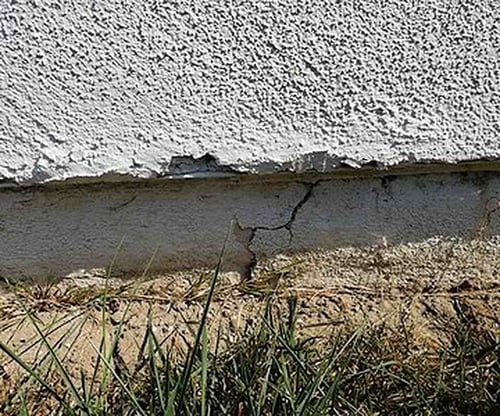Here at Dalinghaus Construction Inc. – we believe the only three guarantees in this life are death, taxes, and foundation settlement.
It is inevitable, but why?
We believe in asking and answering the big life-changing questions (don’t believe us? See our 25 Questions to Ask When Hiring a Foundation Repair Contractor).
We all know that the basis for all the conceivable questions in the universe can be boiled down to who, what, why, when, and how. This article will do the following:
- Define Foundation Settlement
- Outline Common Signs and Symptoms of Foundation Settlement
- Discuss Soil and Weather in regard to Foundation Settlement
- Answer the meaning of life and other existential queries
*Hint – life really has everything to do with maximum practical recovery or the number 43 – it’s all very confusing.
We are going to tackle Foundation Settlement in some depth because this is truly the crux, the issue, the reason you are on our website.
Foundation Settlement is the Alpha and the Omega, the beginning and the end of this entire issue of foundation repair.
This is such a common affair it has wiggled its way into our everyday word usage – so let’s get settled in!
Definition: Foundation Settlement
What is Foundation Settlement?Foundation Settlement is when a foundation sinks into the earth, compromising the building’s structural integrity. This is due primarily to gravity, climate, seismic activity, and the tick, tick, ticking of time. |
Foundation Settlement can be divided into 2 categories –
1. Uniform – when a structure as an entire cohesive unit sinks in a consistent fashion across all square footage
2. Differential – when a structure sinks out of sync in an uneven fashion
Note – not all foundations are created equal, with many foundations suffering from unregulated footing and compaction (settlement accelerated by human error and/or negligence).
In short, whether you have a slab foundation, a raised foundation, or a post-tension foundation – all foundations are susceptible to settlement.
Why?
Answer: soil is the foundation for your foundation and soil moves (up, down, around, and side-to-side like the cha-cha slide).
This question is typically addressed during your foundation inspection.
We will cover why soil moves in a moment, but first let’s take a moment to enjoy the natural, grotesque art-work soil can erect around our home. It is a hybrid performance piece / visual medium.
Signs of Foundation Settlement
Common signs of foundation settlement include sticky doors, cracked drywall, sloping floors, and baseboards that pull away from the walls.
For a FREE Foundation Repair Signs and Symptoms Checklist, click the link below –
We cover these visual and tactile expressions of expansive soil and gravity in our thrilling read 5 Signs of Foundation Issues.
As far as auditory indicators go – you might hear some spooky creaks or groans as you walk across your cherry hardwood floor or hear pops flitting down from the trusses in your ceiling.
Before you call Ghostbusters, make an appointment with a Dalinghaus Specialist to inspect your home for any foundation damage.
Here at Dalinghaus Construction, we believe preventative maintenance is the best form of maintenance.
It is key to raise your foundation as soon as possible before your home/business incurs any additional structural or cosmetic damage.
Note – many homeowners and contractors will address the cosmetic signs and symptoms of foundation settlement without tackling the root of the problem.
For example, drywall is repatched, doors are shaved down, and some floors are re-leveled.
These are not permanent fixes and can cause real problems down the line – see What to Expect When Lifting Your Home.
Once your home is lifted and/or stabilized, after you fix the cosmetic problems, you will not have to address these issues again.
Soil and Weather
As we mentioned earlier, soil is the foundation for your foundation. Settlement is simply caused by soil displacement due to shifting.
Most soil, especially top layers of soil that are still in the active zone, are very susceptible to movement. Soil is not static.
This shifting soil creates air pockets beneath your foundation, displacing the weight of your house. Weight follows gravity.
So, this displaced soil causes your home to sink into/try to fill these crevices. This throws your home off balance.
In short, the real reason your house settles is because the soil below it can no longer sustain the weight of it.
So, something has to give and gravity kicks in and it’s going to cause the least-constructed (weakest) part of your house to fail, sink or settle. This weak soil is referred to as non-load-bearing soil.
9 times out of 10 non load-bearing soil is the key component to why your house settles.
With this in mind, the two primary causes of foundation settlement are:
- Non Load-Bearing Soils
- Water-related issues
1. Non-Load-Bearing Soils
Expansive Soil
A soil, such as clay, that easily absorbs water and consequently increases in volume.
The soil e x p a n d s or contracts based on its water retention at any given time.
In short, the soil rises and falls like incredibly slow-motion dirt waves of pressure, causing damage to structures.
Imagine placing a model of your home on a trampoline. Sure, your home is safe and secure until the rubber begins to bounce. Expansive soil is a very slow trampoline – raising and lifting your home.
Sandy Soil
A major culprit when it comes to foundation shifting, particularly for coastal regions.
Although sand does not retain water like expansive soils, it is easily washed away, leading to erosion that can quickly destabilize any foundation.
Remember when you were a kid and built sandcastles on the beach just to have it washed away by the ocean? Yeah – soil washes out easily, just like in Jesus’ famous parable of the sand vs rock foundation.
Soil Creep
Soil Creep is the gradual downslope movement of soil due to gravity.
Homes built into hillsides may have wonderful vistas, but they are particularly vulnerable to soil creep.
As more and more soil slides downhill, more soil slides out from underneath the foundation.
This is compounded by heavy rain and/or seismic activity.
Water-Related Issues
Here at Dalinghaus Construction, we believe in everything in moderation – water not excluded.
Many homes here in Southern California do not have proper drainage due to our arid climate. If you don’t have rain gutters, when it rains, the water will simply eat-away-at and expose your footing.

In Southern California and Arizona, our footings only go down 18 to 24 inches. When this soil is washed away from your footings, this applies vertical pressure and can crack your foundation and footing.
Improper drainage can also make it easier for water to get into your foundation and rust rebar.
Rebar can expand to 5 times its normal size when rusted and break out chunks of your footing and/or foundation.
In short, too much or too little water can have negative consequences for your foundation – again, it all comes back to soil because the soil is your foundation’s foundation.
We Never Settle
Whether your foundation settlement is the result of soil creep or poor irrigation woes, we have the tools, training, and experience to meet your foundational needs.
We want to provide you with peace of mind knowing that your investments and families are safe. Here at Dalinghaus Construction, we never settle.
If you live in Southern California or Arizona, make an appointment for a FREE foundation evaluation today!







